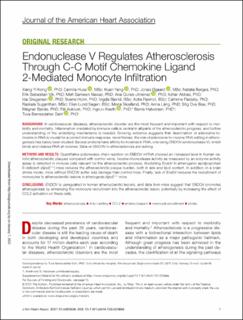Endonuclease v regulates atherosclerosis through c-c motif chemokine ligand 2-mediated monocyte infiltration
| dc.contributor.author | Kong, Xiang Yi | |
| dc.contributor.author | Huse, Camilla | |
| dc.contributor.author | Yang, Kuan | |
| dc.contributor.author | Øgaard, Jonas | |
| dc.contributor.author | Jimenez, Natalia Berges | |
| dc.contributor.author | Vik, Erik Sebastian | |
| dc.contributor.author | Nawaz, Meh Sameen | |
| dc.contributor.author | Quiles-Jiménez, Ana M T | |
| dc.contributor.author | Abbas, Azhar | |
| dc.contributor.author | Gregersen, Ida | |
| dc.contributor.author | Holm, Sverre | |
| dc.contributor.author | Bjerkli, Vigdis | |
| dc.contributor.author | Rashidi, Azita | |
| dc.contributor.author | Fladeby, Cathrine | |
| dc.contributor.author | Suganthan, Rajikala | |
| dc.contributor.author | Sagen, Ellen Lund | |
| dc.contributor.author | Skjelland, Mona | |
| dc.contributor.author | Lång, Anna | |
| dc.contributor.author | Bøe, Stig Ove | |
| dc.contributor.author | Bjørås, Magnar | |
| dc.contributor.author | Aukrust, Pål | |
| dc.contributor.author | Alseth, Ingrun | |
| dc.contributor.author | Halvorsen, Bente | |
| dc.contributor.author | Dahl, Tuva Børresdatter | |
| dc.date.accessioned | 2022-03-25T12:03:34Z | |
| dc.date.available | 2022-03-25T12:03:34Z | |
| dc.date.created | 2022-01-04T15:15:02Z | |
| dc.date.issued | 2021 | |
| dc.identifier.citation | Journal of the American Heart Association (JAHA). 2021, 10 (14), . | en_US |
| dc.identifier.issn | 2047-9980 | |
| dc.identifier.uri | https://hdl.handle.net/11250/2987633 | |
| dc.description.abstract | Background In cardiovascular diseases, atherosclerotic disorder are the most frequent and important with respect to morbidity and mortality. Inflammation mediated by immune cells is central in all parts of the atherosclerotic progress, and further understanding of the underlying mechanisms is needed. Growing evidence suggests that deamination of adenosine‐to‐inosine in RNA is crucial for a correct immune response; nevertheless, the role of adenosine‐to‐inosine RNA editing in atherogenesis has barely been studied. Several proteins have affinity for inosines in RNA, one being ENDOV (endonuclease V), which binds and cleaves RNA at inosines. Data on ENDOV in atherosclerosis are lacking. Methods and Results Quantitative polymerase chain reaction on ENDOV mRNA showed an increased level in human carotid atherosclerotic plaques compared with control veins. Inosine‐ribonuclease activity as measured by an enzyme activity assay is detected in immune cells relevant for the atherosclerotic process. Abolishing EndoV in atherogenic apolipoprotein E‐deficient (ApoE−/−) mice reduces the atherosclerotic plaque burden, both in size and lipid content. In addition, in a brain stroke model, mice without ENDOV suffer less damage than control mice. Finally, lack of EndoV reduces the recruitment of monocytes to atherosclerotic lesions in atherogenic ApoE−/− mice. Conclusions ENDOV is upregulated in human atherosclerotic lesions, and data from mice suggest that ENDOV promotes atherogenesis by enhancing the monocyte recruitment into the atherosclerotic lesion, potentially by increasing the effect of CCL2 activation on these cells. | en_US |
| dc.language.iso | eng | en_US |
| dc.publisher | Wiley Open Access | en_US |
| dc.title | Endonuclease v regulates atherosclerosis through c-c motif chemokine ligand 2-mediated monocyte infiltration | en_US |
| dc.type | Journal article | en_US |
| dc.type | Peer reviewed | en_US |
| dc.description.version | publishedVersion | en_US |
| dc.source.pagenumber | 0 | en_US |
| dc.source.volume | 10 | en_US |
| dc.source.journal | Journal of the American Heart Association (JAHA) | en_US |
| dc.source.issue | 14 | en_US |
| dc.identifier.doi | 10.1161/JAHA.120.020656 | |
| dc.identifier.cristin | 1974542 | |
| cristin.ispublished | true | |
| cristin.fulltext | original | |
| cristin.qualitycode | 1 |
